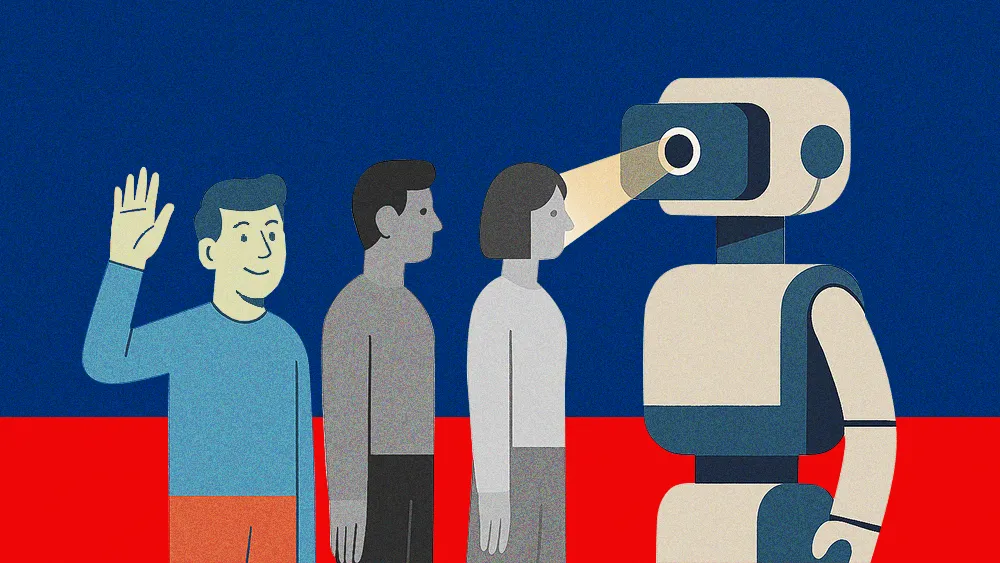AI hiring systems leave employers struggling to fill roles, qualified talent hiding in plain sight

Key Points
AI-driven recruitment tools are contributing to a talent shortage by filtering out qualified candidates before human review.
Bethany Ganz’s job search experience reveals that AI-written resumes often fail to pass automated filters, necessitating a human touch.
Generational and gender gaps in AI adoption are emerging, with millennials more likely to embrace AI skills than older age groups and women.
Empathetic leadership and change management are crucial for overcoming resistance to AI and fostering a unified work environment.
AI doesn't like AI. It's almost as if it will automatically disqualify online applications that are written by a computer. It wants that human element.

Bethany Ganz
Business Development Leader
Gap International
The global talent market is facing a baffling contradiction. Even as headlines announce widespread layoffs, a staggering 74% of employers report difficulty finding skilled talent. The gap isn’t always about availability, but rather how technology screens, sorts, and sometimes silently discards qualified candidates before they ever reach a human.
We spoke with Bethany Ganz, a Business Development Leader at consultancy Gap International, who offers her perspective from the front lines of a recent AI-driven job search. Her experience reveals the company’s internal recruiting AI as the culprit, filtering out qualified people before a human ever sees their name.
Shallow pool: At the recent SHRM conference, the frustration was palpable. “We had these job openings, but for whatever reason, we’re having problems finding the correct candidates for it,” Ganz recalls one attendee observing. “The pool was very small, and we don’t know why.” The disconnect is real, and in many cases, the culprit is not a shortage of qualified talent but the very technology meant to uncover it. Applicant tracking systems and AI-driven screening tools, now a standard part of the hiring process, can silently filter out strong candidates long before a human ever sees their name.
AI doesn’t like AI: Ganz learned this firsthand during her own job search. Like any tech-savvy professional, she assumed AI would be an ally, using it to polish her resume for automated applicant tracking systems. Instead, she was met with silence. “I was applying online and wasn’t getting in touch with a person at all,” she recalls. “I was thinking, ‘What in the world is going on? I have the skills, I have the criteria. I don’t understand.'” The breakthrough came from an ex-recruiter who explained the system’s hidden rules. “AI doesn’t like AI,” Ganz explains. “It’s almost as if it will automatically disqualify online applications that are written by a computer. It wants that human element.”
Her experience is part of a growing trend where AI-written resumes are proving unsuccessful against increasingly sophisticated filters. Ganz discovered the bots would penalize applications for even minor formatting deviations. “If you don’t put the amount of years beside a role, you won’t make it through the filter.” Once she switched to a hand-written resume, the interviews started rolling in.
Beauty in the flaws: The experience helped to shape her AI philosophy. While she uses AI daily for research and to overcome writer’s block, she argues for a clear-eyed understanding of its limitations. “AI is wonderful for anything that doesn’t require human soul,” she says. “It is great for research and computations. It’s a great mimic of human interaction, but you can tell when something has been written by AI versus something written from a person.” That distinction is key. For creative and connective tasks, the sterile perfection of an algorithm falls short. “I think sometimes the beauty is in the imperfections,” Ganz notes, “and AI tries to make things a little too formulaic.”
The adoption gap: That human element is also fragmenting AI’s adoption within organizations. In her own office, Ganz observes multiple generations interacting with technology in vastly different ways, which points to a growing challenge for business leaders: ensuring that the benefits of AI are distributed evenly and that no one gets left behind. Research shows these gaps are real and widening. For instance, some studies suggest that women are adopting generative AI less than men, potentially creating a new skills divide. Similarly, there is a clear generational gap, with data indicating that millennials are leading the charge in AI skills transformation while other age groups may be more hesitant.
For Ganz, bridging these divides comes down to empathetic leadership and smart change management. “A lot of the resistance is because nobody likes change, and people don’t know how it’s going to affect them,” she says. “It’s about trying to take away the fear. The simpler and more practical you make it, the easier it is to bring different generations into a shared way of working.”
I think sometimes the beauty is in the imperfections, and AI tries to make things a little too formulaic.

Bethany Ganz
Business Development Leader
Gap International
I think sometimes the beauty is in the imperfections, and AI tries to make things a little too formulaic.

Bethany Ganz
Business Development Leader
Gap International
Related articles
TL;DR
AI-driven recruitment tools are contributing to a talent shortage by filtering out qualified candidates before human review.
Bethany Ganz’s job search experience reveals that AI-written resumes often fail to pass automated filters, necessitating a human touch.
Generational and gender gaps in AI adoption are emerging, with millennials more likely to embrace AI skills than older age groups and women.
Empathetic leadership and change management are crucial for overcoming resistance to AI and fostering a unified work environment.

Bethany Ganz
Gap International
Business Development Leader

Business Development Leader
The global talent market is facing a baffling contradiction. Even as headlines announce widespread layoffs, a staggering 74% of employers report difficulty finding skilled talent. The gap isn’t always about availability, but rather how technology screens, sorts, and sometimes silently discards qualified candidates before they ever reach a human.
We spoke with Bethany Ganz, a Business Development Leader at consultancy Gap International, who offers her perspective from the front lines of a recent AI-driven job search. Her experience reveals the company’s internal recruiting AI as the culprit, filtering out qualified people before a human ever sees their name.
Shallow pool: At the recent SHRM conference, the frustration was palpable. “We had these job openings, but for whatever reason, we’re having problems finding the correct candidates for it,” Ganz recalls one attendee observing. “The pool was very small, and we don’t know why.” The disconnect is real, and in many cases, the culprit is not a shortage of qualified talent but the very technology meant to uncover it. Applicant tracking systems and AI-driven screening tools, now a standard part of the hiring process, can silently filter out strong candidates long before a human ever sees their name.
AI doesn’t like AI: Ganz learned this firsthand during her own job search. Like any tech-savvy professional, she assumed AI would be an ally, using it to polish her resume for automated applicant tracking systems. Instead, she was met with silence. “I was applying online and wasn’t getting in touch with a person at all,” she recalls. “I was thinking, ‘What in the world is going on? I have the skills, I have the criteria. I don’t understand.'” The breakthrough came from an ex-recruiter who explained the system’s hidden rules. “AI doesn’t like AI,” Ganz explains. “It’s almost as if it will automatically disqualify online applications that are written by a computer. It wants that human element.”
Her experience is part of a growing trend where AI-written resumes are proving unsuccessful against increasingly sophisticated filters. Ganz discovered the bots would penalize applications for even minor formatting deviations. “If you don’t put the amount of years beside a role, you won’t make it through the filter.” Once she switched to a hand-written resume, the interviews started rolling in.

Bethany Ganz
Gap International
Business Development Leader

Business Development Leader
Beauty in the flaws: The experience helped to shape her AI philosophy. While she uses AI daily for research and to overcome writer’s block, she argues for a clear-eyed understanding of its limitations. “AI is wonderful for anything that doesn’t require human soul,” she says. “It is great for research and computations. It’s a great mimic of human interaction, but you can tell when something has been written by AI versus something written from a person.” That distinction is key. For creative and connective tasks, the sterile perfection of an algorithm falls short. “I think sometimes the beauty is in the imperfections,” Ganz notes, “and AI tries to make things a little too formulaic.”
The adoption gap: That human element is also fragmenting AI’s adoption within organizations. In her own office, Ganz observes multiple generations interacting with technology in vastly different ways, which points to a growing challenge for business leaders: ensuring that the benefits of AI are distributed evenly and that no one gets left behind. Research shows these gaps are real and widening. For instance, some studies suggest that women are adopting generative AI less than men, potentially creating a new skills divide. Similarly, there is a clear generational gap, with data indicating that millennials are leading the charge in AI skills transformation while other age groups may be more hesitant.
For Ganz, bridging these divides comes down to empathetic leadership and smart change management. “A lot of the resistance is because nobody likes change, and people don’t know how it’s going to affect them,” she says. “It’s about trying to take away the fear. The simpler and more practical you make it, the easier it is to bring different generations into a shared way of working.”




